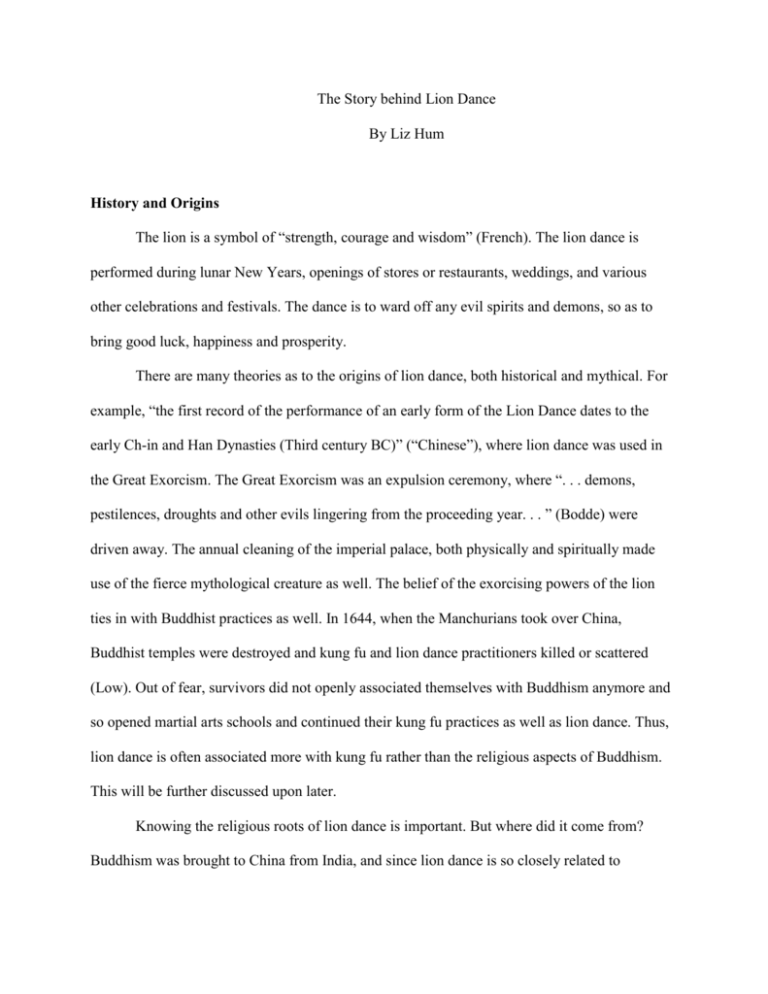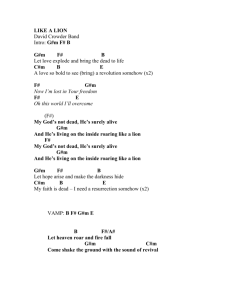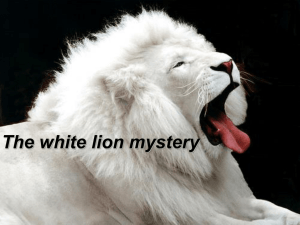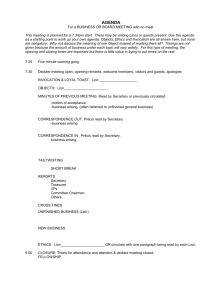The Story behind Lion Dance - East Rising Lion Dance Troupe
advertisement

The Story behind Lion Dance By Liz Hum History and Origins The lion is a symbol of “strength, courage and wisdom” (French). The lion dance is performed during lunar New Years, openings of stores or restaurants, weddings, and various other celebrations and festivals. The dance is to ward off any evil spirits and demons, so as to bring good luck, happiness and prosperity. There are many theories as to the origins of lion dance, both historical and mythical. For example, “the first record of the performance of an early form of the Lion Dance dates to the early Ch-in and Han Dynasties (Third century BC)” (“Chinese”), where lion dance was used in the Great Exorcism. The Great Exorcism was an expulsion ceremony, where “. . . demons, pestilences, droughts and other evils lingering from the proceeding year. . . ” (Bodde) were driven away. The annual cleaning of the imperial palace, both physically and spiritually made use of the fierce mythological creature as well. The belief of the exorcising powers of the lion ties in with Buddhist practices as well. In 1644, when the Manchurians took over China, Buddhist temples were destroyed and kung fu and lion dance practitioners killed or scattered (Low). Out of fear, survivors did not openly associated themselves with Buddhism anymore and so opened martial arts schools and continued their kung fu practices as well as lion dance. Thus, lion dance is often associated more with kung fu rather than the religious aspects of Buddhism. This will be further discussed upon later. Knowing the religious roots of lion dance is important. But where did it come from? Buddhism was brought to China from India, and since lion dance is so closely related to Buddhism, perhaps it originated from India as well. Many cultural influences passed between China and India through the trade routes. Some would even suggest that lion dance as a part of kung fu was a means for travelers to better defend themselves on the route. Or perhaps lion dance was adapted by the Chinese when Persian performers in China celebrated their “new day” festival, which was similar to the Lunar New Year’s festivities. Similarly, the lion dance was used to expel and ominous spirits as well as for celebrations in Korea too. An account of such festivities explains how: On every night of [the] first fifteen nights of the Lunar New Year, the village people of Bukcheong region used to perform lion dance. The dance troupe . . .would visit every house in the village and look into every corner of the house, even into the barn and privy as if to eat up all malicious spirits hidden in the house. When the exorcising rite was over, the house owner would donate rice and filled sacks of rice were utilized as the communal fund to support the village festival, public affairs, scholarships, needy neighbors and old people. The owner would have his children ride on the lion’s back and would attach threads of five colors to its mane wishing for their health and longevity (Heo). Unfortunately, such rituals have almost disappeared these days and the elaborate rites are lost to the modern world. Lion dance is popular in practically all of East Asia, and anywhere else where there are Chinese people to spread the culture. Lion dance is seen more as a cultural activity than a spiritual and religious rite now. This will also be addressed more later. On another note, since historical origins of lion dance are just as unclear, there are several mythological approaches to explain the origin of lion dance. During the Tang Dynasty, the emperor had dreamed that a creature had saved his life. When he described the creature to his ministers, they told him it was a lion, and so the emperor commanded that they recreate the lion out of bamboo and paper-mache. Thus, the lion became a symbol of good luck, happiness and prosperity. Another story involves a monster, Nian, which appears during the New Year to destroy the crops. The villagers made noise with gongs and cymbals to scare it off. Another version even mentions the people imitating Nian and dressing up in costumes to scare the beast away. Also, there is a myth about how a rat-infested village struggled, looking for a way to be rid of the rats. The lion ate all the rats and saved the village, but it then turned on the people. The villagers then dressed up in lion costumes and made a lot of noise to scare off the lion. A variation of this story has a Buddhist monk in it who teaches the lion Buddhism, thereby taming the beast. The lion then becomes protector of the village. There is another story involving the lion and a Buddhist monk as well. Both are on a quest for a mythical mushroom (loong gi), which has great healing properties, and happen to meet and join together. While on the quest, the monk teaches the lion Buddhism and in return, the lion protects the monk from harm. Another tale depicts the lion as a heavenly creature, always causing trouble and playing jokes on others. One day, the lion played a joke on the Jade Emperor and angered the emperor so much, he cut off the lion’s head. Kwan Yin, the goddess of mercy took pity on the lion and used a red ribbon to reattach the lion’s head to its body. She also gave it a horn on its forehead to fight with and a mirror to frighten away evil spirits. The “beauty and the beast” archetype developed by renown psychoanalyst, Carl Jung can be applied to this myth. Kwan Yin saw the inner strength of the lion and also became the lion’s anima. “The anima is a female within the subconscious of every male that serves as his guide in the subliminal world” (Low). Much like the Buddhist monks, Kwan Yin taught the lion to become good, and through their teachings, the lion became righteous and turned away from a life of doing bad. There is a direct historical connection between kung fu and Buddhism. It can be noted that “it was in China that early systems of health-giving breath and body exercises were developed by Buddhist monks to assist in the rigors of life and in the achievement of meditational goals” (Zarrilli). Some practitioners have even joked about how kung fu was developed to liven up the civilian Buddhists, who would often have trouble staying awake while meditating. Since kung fu is so closely related to Buddhism, and there is also a connection between those two with lion dance, it is obvious that lion dance would be closely associated with kung fu. Because of the acrobatic moves as well as strenuous stances, lion dancers must be in good physical condition. Many of the stances and footwork also reflect kung fu moves, and so oftentimes kung fu schools also do lion dance, but that doesn’t mean all lion dance troupes know kung fu, nor do all kung fu schools teach lion dance. In accordance to the Buddhist exorcising powers that the lion has, kung fu masters used lion dance as means to “. . . guard their villages with their fighting skills, and also shield citizens from misfortune on a mystical level” (Ching). This was back when kung fu and lion dance were still strongly associated with the religious aspects of their Buddhist roots. Modern Day Lion Dance Later on, lion dance became known only for its kung fu roots. Lion dance was a “. . . peaceful way for kung fu fighters to test each other’s skill” (Ching). Troupes usually do not fight each other with lions though. Before lion dance, there were kung fu competitions. In the 50’s, 60’s, and early 70’s, there were a lot of [martial arts] matches . . .all full contact . . . because of one incident, a full-contact competitor died, and Hong Kong government stopped it. No more full-contact tournaments. Then Lion Dance competition began. Prior to that, Lion Dance competition didn’t exist (Ching) Even though there is far less contact in Lion dance competitions, it is still a duel between rival lion dance troupes. The competitions allow schools to show off their upper body strength by how powerfully the lion head is shaken, their stance skills with their fancy footwork, cunning and agility with how they get their lucky offering, and even their fighting skills by knocking a rival lion on its butt. To them, lion dance is “. . . a matter of pride and is taken very seriously” (French). Kung fu schools were often very territorial. They were the protectors of whichever village or region they were in, and so having rival schools in the same area would prove to be competition when their services were required. In traditional kung fu schools, “. . . the students did not pay a fee. Instead, the club raised all its funding for the year by competing in special lion dancing competitions held during the Chinese New Year” (French). This added factor of money made lion dancing even more competitive. Payment for lion dancing varied. The traditional way of presenting payment is by using lay see (li shir) in the form of a hung bao (lucky red envelope with the payment enclosed inside). This can usually be held out and offered to the lion, or it can be tied to some real or pretend vegetables, such as loose leaf lettuce which the lion “eats.” According to lion dance sifu, Jane Hallander: This tradition dates back to the Ching dynasty when Chinese patriots were rebelling against the Ching (Manchu) overlords. The lion dance was performed all over the area where the revolution was taking place. Under the cover of the festival, the “performers/revolutionaries” were exchanging information and the money they had collected from various rebel groups. In those days the performers with the lion head would yell “choi Ching” (“get the Ching”) in order that any rebels present would know that he was one of them and could receive secret messages. If there were any Ching informants in the audience they would immediately recognize the performer’s yell. Therefore, since the word Ching sounds like the word chiang, meaning “green” (as in lettuce or money), the password was changed. The “yell” then became “Choi Chiang” (“get the green”) and is still used today as the name of that particular type of lion dance (Hallander). If performing for weddings or restaurant openings, sometimes the troupes would also get their own table and join in for the banquets. For such performances where choi chiang might be too messy, a scroll with a message written in calligraphy is unfurled from the lion’s mouth instead. The owner or married couple would then be able to keep the scroll as an offering for good luck. Aspects of Lion Dance There are many factors of a lion dance performance. Performers would include a lion head, tail, drummer, cymbals, and gong. Sometimes there would be a “Big Head” which is a person in an overly large mask which plays with the crowd as well as the lion. He would usually carry a wine jug, fan, or pearl in his hand, which can be used as a prop in the performance. There are eight basic aspects to a performance routine: sleeping, opening, playing, searching, fighting, eating, closing, and sleeping. Of course, a performance does not necessarily need to include all of these aspects. Troupes normally have different variations to their performances and their own styles. Depending on the amount of space available for the performance, troupes will have to coordinate routines to match the amount of space available for them to maneuver in. The head and the tail coordinate to have synchronized movements as well as do acrobatic balances and tricks. Some examples are 2 leg (head stands on tail’s 2 legs), 1 leg (head stands on tail’s 1 leg), head sitter (head sits on tail’s head), shoulder stack (head stands on tail’s shoulders), and oracle (head wraps legs around tail’s torso and tail swings the head down in an arc). Such acrobatics require that both the head and tail be in good physical condition as well as balance. During celebrations and competitions, lion dance troupes much show both sportsmanship and respect for other teams. There are certain “rules” that all teams must follow, including lion dance etiquette: 1. When a team comes across an association or temple, they must apply the greeting drum beat as a respect for each other 2. When a team meets another on its way, greetings must be exchanged in a form of a greeting card. The lion must not kick their legs or swing the head and they should keep their mouth closed. 3. During Chinese festival seasons, there are always lion dance teams meeting a dragon dance team. The lion dance team should always show their respect, otherwise when the dragon attacks the lion by surrounding it, the dancers would have to be very skillful to jump clear of the dragon’s hold (Hup). Since the teams are very competitive, one should not do anything to provoke another troupe so as to avoid any confrontation and fighting. Each school has its own distinct style of lion dance. For example, “. . . in Hung Gar (Hung Jia in Mandarin), the students practice very deep “horses” (stances), with the power coming from the thrusting and rotation of the waist. In Choy Lai Fut (Tsai Li Fo), movements are quicker” (“Chinese”). The most popular styles now are the southern styles, hok san (crane mountain) and fut san (Buddha mountain). According to founder of East Rising Dragon Lion Dance Troupe, Mok-yi Chow, “. . .most of the global [troupes] are hok san now, the contemporary version. The traditional fut san isn’t too popular in these [lion dance] competitions due to the length of the tail . . . harder to do tricks” (Chow). Hok san is more choreographed, making it harder to free style during a routine. Each lion movement is supposedly linked to one drum beat so that both are coordinated with each other’s movements. Hok san draws graceful arcs with the lion head to make the rounded mouth look good, whereas fut san uses forceful “jerks” to make the lion seem fierce. That’s why their lions look so fast and powerful. Fut san stances are all from kung fu; different kung fu schools usually have different styles and stances. However, hok san is not as strict on stances and make the movements seem more relaxed and natural. The lion heads are also different fro hok san and fut san. Hok san lion heads are usually smaller than fut san, have a rounded mouth, and the horn on the lion’s forehead is rounded like a fist, where as fut san horns are sharp and the mouth is more squared. Structure and Styles of Lions A lion head is traditionally made of bamboo and papier-mâché. Now lion heads can be made of aluminum or PVC instead. There are strings attached to its ears and eyes so that when pulled, the ears wiggle and the eyes blink. The lion also has a hinged mouth which can open and close, and even a furry tail which has a stick attached to it, so that the tail can be wagged, making the lion even more realistic looking. Despite the movements and movable ears and eyes, the lion still has little resemblance of a real lion! The lion has a horn and a mirror on its forehead! The myth of Kwan Yin and the mystical lion may explain why the lion has a horn and mirror on its forehead. There are many various styles of lion heads and bodies too. The northern lion has long hair and is usually gold or yellow. It has much more realistic features than the southern lion, which is heavier, and so less suitable for acrobatics. The southern lion has usually a brightly colored head and body, and is not hairy. It is a lot less realistic, and has many variations on the color theme. For example, a multi-colored face with a white beard signifies intelligence, bravery and kindness. It is also associated with General Liu Pei. A red face with a black beard signifies bravery, happiness, good luck and prosperity. It is also associated with General Kwan Kung, who is said to have had a red face as well. A black face with a black beard is related to General Chang Fei and represents bravery and strength. A black lion is also the color of a fighting lion, and its features are much more fierce and intimidating. The Generals were each a sworn brother of the Peach Orchard. The color of the beard is actually associated with the age of the lion dance troupe. An older troupe would use a lion head that has a white beard, and a younger troupe’s head would have a black beard, unless their lion was bestowed upon them from an older group. Each lion also has matching pants for the performers to wear, so that their legs can match with the lion’s body. There are even special shoes that have furry pom-poms and “paws” to even make the performers’ feet match with the lion. Even the simplest of costumes can be very elaborate. Lion Dance Worldwide Lion dance can be seen in anywhere where there is a Chinese population. Lion dance is popular in most of East Asian, including China, Taiwan, Hong Kong, Malaysia, Philippines, Korea, and Singapore. It is also practiced in Hawaii, and all over the United States, especially in San Francisco, New York, and the Washington DC metropolitan area. Troupes in Malaysia have even introduced a new style of lion dancing, which fused the southern style lion heads with the shorter and more acrobatic northern tails. Grandmaster Ha believed that, “this new design allowed Lion Dancers the best and most challenging aspects of both regions . . . [Ha] brought it back to Hong Kong and spread it throughout southern China” (Ching). Lion dance is constantly evolving to magnify the skills required for this art. There are also international competitions that are held where teams from around the world gather to proclaim their skills. Changes in Lion Dance Lion dance today has branched from the traditional lion dance immensely. Besides the loss of the religious aspects, lion dance has also distanced from the social aspects associated with the traditional troupes. According to Wen Haur Choo, being in a lion dance troupe is not the same as it was in the “old days.” This is not referring to the “old days” as in ancient china; this is more like the 50’s-60. Before, people who joined lion dance troupes were “gangster-like” and there was a lot of fighting amongst lion dance troupes and kung fu schools. Parents were afraid of letting their children join lion dance troupes because of the “gangster” association to the members. During festivals and performances, when lion dance troupes meet, there are “fights” between groups. Some lifts and acrobatic tricks are designed for the lion to “fight” and knock over other rival lions. Performers might even hide daggers in their shoes, which can be used to injure other lion dancers’ legs, or even attach a metal horn on their lion’s forehead, which can be used to slash other lion heads. For instance, the violence got so extreme that at one point, the Hong Kong government had to put a stop to lion dance completely. Now, lion dance troupes must attain a permit from the government in order to do lion dance. Although there is still a certain degree of competitiveness, troupes are a lot less violent and aggressive. Nowadays, lion dance is a “. . . more sport-oriented activity . . .” (Choo). Lion dance is more for recreation than a way of living. In Hong Kong, the youth are even more spirited, where “once a week, a group of young people meet on this roof . . . helping to preserve the traditions of Chinese shadow boxing and the lion dance” (Worth 31). The lack of space indoors makes it difficult for any activities, and so lion dance and boxing is invaluable to the youth as their only opportunity for recreation. Lion dance is even a family event. Children ages 2-16 eagerly learn lion dance too. Being “influenced by their fathers, who are the members of the Zhaoqing Dianli Lion Dance Troupe, the children took interest in this special kind of art at an early age” (“Children” 23). Contemporary vs. Traditional Lion Dance Much of this controversy still stands today, even in America. There are many contemporary groups that see lion dance as a hobby, a form of recreation, and those that are still very traditional and view lion dance as their pride and dignity. When these groups clash, there is much misunderstanding which bars the groups from cooperating in spreading the lion dance culture. Traditionally, “. . . access to the martial arts was carefully restricted . . . many techniques, especially those considered most dangerous, are secret, disclosed only to the most advanced and trusted students” (Zarilli). In paralleling the kung fu schools’ thinking, lion dance is often kept secret. Many traditional troupes refuse to share information about how their troupe dances and routines and moves they prepare for. There is a strong in-group feel. Contemporary troupes are more open to sharing information and helping other “start up troupes” with learning moves and proper stances. There is not the strict need to keep information secretive; to contemporary troupes, lion dance is an important cultural aspect that is meant to be shared with anyone interested. From personal experience with the East Rising Lion Dance Troupe, lion dance is not about publicity or money or territory anymore. Lion dance is fun, and a way to learn more about cultural roots and share them. The experience from performing in public is satisfying in itself; monetary gain is not necessary. The funds that are gained from performances are used to pay for new equipment and lion heads; none of it goes to individual group members. This way of running the troupe puts a lot less pressure and strain on the group as a whole because there is no stress about earning money and being the best in order to drive off competition for performances and business opportunities. Without those factors, East Rising Dragon is able to enjoy learning and performing lion dance a lot more. However, traditional teams often hold the misconception against start up contemporary groups that they are performing without necessarily believing in the traditional religious aspects (Le). For many contemporary troupes, lion dance is a sport and form of recreation. While some do have an understanding of the traditions, a member of a traditional kung fu school remarks that they are “nothing more than entertainers putting on a show” (Kong). From another perspective, the tension and ill feelings from traditional troupes may be spurred by “jealousy of a new team” (Le) and the fact that another troupe would mean more competition, resulting in them losing business. On the other hand, the traditional values that kung fu schools hold remain to be beneficial for lion dancing. For example, because of the kung fu stances and physical training, students are better able to learn the proper forms of lion dance. Students are more motivated to learn the art, and learn it well because it is a source of income for the school, as well as the pride and dignity of the troupe. Contemporary troupes may not have the same drive to learn the art well, and individuals’ skill range may depend on their individual dedication to learning lion dance. Traditional troupes value the quality of their performance as well. It would shame the school if they performed incorrectly in public, whereas non-traditional troupes are more relaxed about their style and stances and movements. This can be a downside, because non-Chinese audiences may be witnessing improper styles of lion dance, but on the other hand, it leaves room for individual groups to add in their own unique flare in the troupe’s style. It is important to understand that not all lion dance troupes teach kung fu, nor do all kung fu schools teach lion dance. Some of the top lion dance troupes in the world are not associated with kung fu, but are influenced by it through the stances, footwork, and physical endurance required for lion dance. Women and Lion Dance Much like in the real world, lion dance also discriminates against women. A traditional belief is that women are not allowed to take part in lion dance. This is due to the Taoist teachings that women are “yin” while the lion is “yang,” and so the two cannot intermingle. When women have their menstrual period, they are not allowed to even touch the lion, because they are “unclean” (Chow). This explains why many troupes only allow girls to be a part of the instrumental team, and not take part in the actual lion dancing. Later, girls were allowed to be in the lions, but only if the pair performing were both women. Contemporary groups are now allowing girls to be paired with a male to perform in lion, but this is still considered to be taboo in most standards. With the rise of female equality in today's society, maybe one day the female/male pair will be considered acceptable as well. Conclusion When traditional and contemporary thinking clash, it is difficult for both to co-exist. These are two major trends for troupes these days, but there are non-extremists as well. There are traditional lion dance troupes with really open minds that offer to help newly started contemporary troupes, and there are contemporary troupes that only perform during Chinese New Year for the sole purpose of monetary gain. These may be just generalizations, but for the most part, it is often just misunderstandings that cause tension between traditional and contemporary troupes. Regardless, lion dance is still a highly valued art that is deeply rooted in the Chinese culture. People of all ages can relate to the dance of the lion and feel blessed after watching a performance. Lion dance is much more than just a performance put on by two people under a papier-mâché lion, and much more than an art. There is a complex history behind this seemingly straightforward, entertaining folk sport. It is a tradition that has been maintained for many centuries, and with its popularity growing globally, it can continue being handed down for many generations to come. Works Cited Bodde, Derk. Festivals in Classical China: New York and other annual observances During the Han Dynasty 206 BC-AD 220. New Jersey: Princeton University Press, 1975. Bodde, Derk. Annual Customs and Festivals in Peking. Hong Kong: Hong Kong University Press, 1965. “Children Lion Dancers Win a Name.” Beijing Review. 42.3 (1999): 23. “Chinese Lion” 11 Jun 2002. Chinese Historical and Cultural Project. 12 March 2005. <http://www.chcp.org/lion.html>. Ching and Richard Wan. “The Lion King: Grandmaster Ha Kwok Cheung and the fighting lions of Yao Kung Mon.” Kung Fu Magazine 2004. 18 March 2005. <http://ezine.kungfumagazine.com/magazine/magazine.php?magyr=2004>. Choo, Wen Haur. Personal Interview. 10 March 2005. Chow, Mok-yi. Personal Interview. 3 Feb 2005. French, Andy. “The Chinese Lion Dance.” Lau Gar in Stafford. 7 Sept 2003. British Kung Fu Association. 12 April 2004. <http://www.stafford-lau-gar.co.uk/ articles/liondance1.html>. Hallander, Jane. “Lion Dancing.” Golden Eagle Martial Arts Center. 12 Jan 2004. Golden Eagle Martial Arts Center. 17 March 2005. <http://goldeneaglemart.com/ modules.php?name=content&pa=showpage&pid=6>. Heo, Young-Il. “Bukcheong Saja-nori: Lion Dance of Bukcheong.” Data Bank on Traditional/Folk Performing Arts in Asia and the Pacific. Asia/Pacific Cultural Centre for UNESCO. 22 March 2005 <http://www2.accu.or.jp/paap/data/ A_KOR3.xml?mode=detail1#top>. Hup, Tan Lian. “Southern Lion.” Rising Dragon Feng Shui 3 May 2004. Rising Dragon Enterprises. 3 March 2005. <http://www.rising-dragon.co.uk/articles/martialarts/ southern-style-kung-fu-lion-dance.htm>. Kong, Nick. Personal Interview. 2 March 2005. Le, Albert. Personal Interview. 2 Feb 2005. “Lion Dance” 3 Feb 2000. Wing Chun. 10 April 2004. <http://liondance.free.fr/>. Low, Christopher. “The Lion Dance: Myths and Meanings.” The Lion’s Cave. April 2000. 12 March 2005. <http://www.geocities.com/lioncave1/Articles/ Myth.html#introduction>. Worth, Edith. “On a roof in Hong Kong.” Dance Magazine. (1967): 31-32. Zarilli, Phillip B. “Asian Martial Arts”. International Encyclopedia of Dance. Vol. 1. New York : Oxford University Press, 1998.









